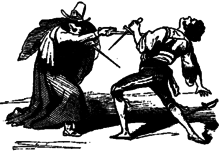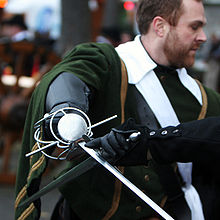This articleneeds additional citations forverification.(November 2012) |
Theparrying daggeris a category of small handheld weapons from the Europeanlate Middle Agesand earlyRenaissance.These weapons were used as off-hand weaponsin conjunctionwith asingle-handed swordsuch as arapier.As the name implies they were designed toparry,or defend, more effectively than a simpledaggerform, typically incorporating a wider guard, and often some other defensive features to better protect the hand as well. They may also be used for attack if an opportunity arises. The general category includes two more specific types, theswordbreakerandtrident dagger.[1]


The use of this off-hand weapon gradually fell out of favor asswordfighting evolved into the modern sport offencing.The use of progressively lighter primary weapons such as thesmall sword,épée,andfoilallowed for greater speed since the fencer needed less protection for himself as double hits became more allowed in sport fencing.
Early development
editParrying daggers were an important development of the ubiquitous quilliondaggerform, appearing in the early to mid-16th century starting with the so-calledleft hand dagger.Although this is often used as a term of convenience for parrying daggers in general, it also refers more specifically to the earlier and simpler form of the weapon. It had stoutquillons(straight or curved) for effective parrying as well as an additional guard in the form of a ring or shell on one side of the quillons where they crossed the grip. In addition to straight blades, there are examples of left hand daggers with wavy blades, those with saw edges and blades that are perforated along the centralfullerwith small holes, all designed to make the weapon lighter or to aid in defense.[2]This form of dagger largely disappeared in the early 17th century in favor of the much more importantmain-gauchewhich was especially popular inSpainandItaly.Thetriple daggerandswordbreakerwere rare and relatively late developments, first appearing around 1600. Parrying daggers were often madeen suite,or similar in terms of construction and decorative technique, to the sword with which they were paired as acompanion weapon.[3][4][5]
Dagger types
editMain-gauche
editThe main-gauche (Frenchfor "left hand",pronounced[mɛ̃ɡuʃ]) was used mainly to assist in defense by parrying enemy thrusts, while the dominant hand wielded arapieror similar longer weapon intended for one-handed use.[6]It was a relatively large dagger, having a longer and heavierblade(often measuring 19 in (480 mm) or slightly more in length) and very long, straight quillons. Its most characteristic feature was a wide knuckleguard that curved from the quillons to thepommeland protected the hand. The guard was usually (but not always) triangular in outline, and the quillons typically measured 11 in (280 mm) or more from tip to tip.[3][4][5]
Since this style of dagger was usually madeen suitewith a cup-hilted rapier, the decoration of the knuckleguard tended to reflect that of the cup of the rapier. The edges of the guard are usually turned over toward the outside, possibly to trap the point of the opponent's blade and prevent it from slipping into the defender's hand. The quillons are normally cylindrical with knobbed tips, and in many instances are decorated with spiral fluting. The pommel is normally decorated to match the quillons and made to resemble the pommel of its matching rapier, while the grip is usually made of wood and wrapped with twisted and braided wire.[3][4][5]
The blade is normally made in three distinct sections or zones. The first section, near thehilt,comprises thericasso(unsharpened portion) which is flat-sided and slightlybeveledat the edges with one or two small holes at its forward end. In some examples there are two arms running parallel to the sides of the ricasso with spaces inbetween, designed to catch the opponent's blade in a manner similar to the curved quillons of a dagger. On the side of the ricasso opposite the knuckleguard there is usually an oval depression for the thumb. The second section of the blade is normally single-edged with a flat triangular cross-section. The edge faces the wielder's left when the dagger is held in the ready position. The back of the blade (the dull edge) in this section is usually filed with a series of grooves or notches. The third and longest section of the blade extends to the point, and is double-edged with a diamond cross-section. It will occasionally have notches or serrations for a short distance along the edge which corresponds to the back of the previous zone. Although this form is typical, numerous variations can be found including those with curved quillons, rounded guards or blades with only two sections. These various forms reached their peak of development in the late 17th century and, despite a period of decline, the weapon continued to be used even into the 18th century.[3][4][5]
Swordbreaker
editThe swordbreaker was a dagger that had large, deepserrationsalong one side of the blade, resembling the barbed teeth of a comb and designed to entrap an opponent's blade, allowing a variety of follow-up techniques. Like the triple dagger, the swordbreaker was a rare form of parrying dagger compared to the main-gauche, partly due to the difficulty of crafting such a specialised weapon. One Italian example dated around 1600 can be found in theWallace CollectioninLondonand has a hilt consisting of a pair of straight quillons and a ring guard.[3][5][7]
Despite the nameswordbreaker,it is uncertain whether they could in fact break sword blades as suggested by some scholars,[5][8]as swords of this era were intended to stand up to substantial forces, well in excess of what could be generated by a fighter's off-hand. Swords are sometimes depicted inFechtbüchernas withstanding a two-handed attempt to break them (or show off their resilience).[9]Late Renaissance rapiers and smallswords may not be as robust as the cutting swords of earlier times, however, and have indeed been known to break on occasion, so the claim may have more veracity in relation to the typical civilian weapons of this period.
The term is also applied in modern times to the various devices (such as hooks or spikes) found on somebucklerswhich served the same purpose as the parrying dagger to entrap an opponent's blade.[10]
Trident dagger
editTridentdaggers (or triple daggers) have blades divided lengthwise into three parts which fold together to resemble a conventional blade. When a mechanism near the hilt is released the two side blades open under spring pressure to form the "trident", flying apart until they are stopped by the ends of the curved quillons. This creates a dagger capable of trapping blades more securely and easily. Like the swordbreaker, the triple dagger was a rare form of parrying dagger compared to the main-gauche.[3][5][11]
Modern usage
editAn off-hand weapon is rarely used in modern sport competition. In fact, the use of the off-hand as a defensive measure is often prohibited by the rules of many sport fighting styles that are common in theWestern worldtoday. However, in HEMA (historical European martial arts) Rapier and Dagger is a commonsparringmethod, andbackswordand dagger is also practised. Another exception iskendowhere the use of twoshinaiof different size is allowed but uncommon; this style is known asnito-ryu(literally "two sword-style" ). Several other fighting styles not only incorporate but even promote off-hand weapons, for example classical styles ofFilipino Martial Artswhich commonly haveEspada y Dagaor Sword-and-dagger systems.[12]Simultaneous use of two weapons is also frequently featured in fiction, particularly in video games, literature, and other media from thefantasygenre, where it is commonly dubbed "dual wielding".In theSociety for Creative Anachronism(SCA),rapier combatmakes use of various forms of off-hand device, including parrying daggers, batons, cloaks, and a second sword, which in fencing is termed a "case of rapier".
See also
editReferences
edit- ^"Forms of European Edged Weaponry".myarmoury.Retrieved2012-11-10.
- ^German left hand dagger and sheath,Victoria and Albert Museum
- ^abcdefPeterson, Harold (2001).Daggers and Fighting Knives of the Western World.Dover Publications.ISBN0-486-41743-3
- ^abcdHayward, John (1963).Victoria and Albert Museum Swords and Daggers.Her Majesty's Stationery Office,London.ISBN978-0112900771
- ^abcdefgOakeshott, Ewart (2000).European Weapons and Armour.pp. 229-231.Boydell Press.ISBN0851157890
- ^Giacomo Di Grasse,True Art of Defense, IX. Rapier and Dagger,1570, first edition in English 1594. (accessed Aug. 14 2013)
- ^"Treasure of the Month: A Sword-Catching Parrying Dagger Italian, c. 1600".Wallace Collection.July 2012. Archived fromthe originalon 2015-10-25.Retrieved2019-07-11.
- ^Weliwitigoda, Chatura."Weapons of the 17th Century"(PDF).Retrieved1 August2014.
- ^"Fight-Book Clues to Quality and Build of Knightly Weaponry".Thearma.org.Retrieved2012-11-10.
- ^Blair, Claude and Tarassuk, Leonid, eds. (1982).The Complete Encyclopedia of Arms and Weapons.p.105.Simon & Schuster.ISBN0-671-42257-X.
- ^"Combination Weapons".myarmoury.Retrieved2012-11-10.
- ^"Abaniko Tres Puntas History".Abaniko Tres Puntas.Retrieved9 December2023.
External links
edit- "Forms of European Edged Weaponry".myarmoury. 2003.Retrieved2007-11-24.
- Jeffrey Hull (2007)."Fight-Book Clues to Quality and Build of Knightly Weaponry".Thearma.org.Retrieved2007-11-24.
- Chad Arnow."Spotlight: Combination Weapons".myarmoury.Retrieved2007-11-24.
- "Arms and Armour in the Age of the Musketeer".Archived fromthe originalon 2007-02-16.Retrieved2007-05-13.
- A swordbreaker put to the test.youtube. Feb 28, 2016.